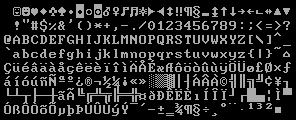OLED Display
Intro
I really like the neat little OLED displays. They are crisp and draw only some miliamps. Cheap OLED display have a resolution 128x32 that's enough for about 4 lines and 20 characters.
Driver oled.c , fonts from https://www.mikrocontroller.net/topic/54860
, fonts from https://www.mikrocontroller.net/topic/54860 .
Code page 850
.
Code page 850


OLED and I2C Words
oled-emit works like the standard word emit. It blocks the calling thread, as long as the character is not written to the OLED display (less than 300 us for a 6x8 character and 400 kHz I2C). Horizontal (x) position is in pixel (0 to 127), vertical position (y) is in lines, a line consists of 8 pixels. 0, 0 is upper left corner. Larger fonts takes more than one line.
oled-emit ( Char -- ) Emits a character (writes a character to the OLED display)
oled-emit? ( -- Flag ) OLED ready to get a character (I2C not busy)
hook-emit ( -- a-addr ) Hooks for redirecting terminal IO on the fly
hook-emit? ( -- a-addr )
oledpos! ( x y -- ) Set OLED cursor position,
x (column) horizontal position, max. 127
y (row) vertical position (a line consists of 8 pixels), max. 3 for 128x32 or 7 for 128x64 displays.
oledpos@ ( -- x y ) Get the current OLED cursor position
oledcmd ( c-addr -- ) Send command to the OLED controller SSD1306. First byte contains the length of the command.
oledclr ( -- ) Clears the OLED display, sets the cursor to 0, 0
oledfont ( u -- ) Select the font, u: 0 6x8, 1 8x8, 2 8X16 , 3 12X16
oledcolumn! ( u -- ) Write a column (8 pixels) to the current position. Increment position. Bit 0 on top
oledcolumn@ ( -- u ) Read a column (8 pixels) from the current position
I2Cdev ( u -- ) Sets the 7-bit I2C address
I2Cput ( c-addr u -- ) c-addr buffer address for the message with lengh u to send
I2Cget ( c-addr u -- ) c-addr buffer address for the message to receive
I2Cputget ( a1 u1 a2 u2 -- ) a1 buffer address for the message to send, a2 buffer address for the message to receive
>oled ( -- addr1 addr2 ) redirect to oled *)
>term ( addr1 addr2 -- ) terminate redirection *)
*) part of redirection.fs
Usage
It is easy to redirect the terminal output to the OLED display, to use the string formatting words.: oled-hallo ( -- ) hook-emit @ \ save emit hook ['] oled-emit hook-emit ! \ redirect terminal to oled-emit ." Hallo Velo! " cr ." ciao" hook-emit ! \ restore old hook ;or even simpler
: oled-hallo ( -- ) >oled \ redirect terminal to oled-emit ." Hallo Velo! " cr ." ciao" >term \ terminate redirection ;or on a command line
>oled .( Hallo Velo!) >termshow date and time on OLED (see CmsisRtos#How_to_use_Tasks for a background task).
: clock ( -- )
oledclr
3 oledfont
-1 -1 -1 alarm! \ set an alarm every second
begin
wait-alarm \ wait a second
0 0 oledpos!
>oled .time >term
key? until
key drop
;
To change the display type you have to edit the oled.h#define OLED_4PIN_128X32 0 // the cheap one with 4 pins, Adafruit Raspberry Pi #3527 #define OLED_BONNET_128X64 1 // Adafruit Bonnet for Raspberry Pi #3531 #define OLED_FEATHER_128X32 2 // Adafruit FeatherWing #2900 #define OLED_FEATHER_128X64 3 // Adafruit FeatherWing #4650 #define OLED_OCTOPUS_128X64 4 // Octopus PIS-1277 #define OLED_LANDSCAPE 0 #define OLED_PORTRAIT 1 // configure your OLED type #define OLED_DISPLAY_TYPE OLED_OCTOPUS_128X64 #define OLED_ORIENTATION OLED_LANDSCAPE
Links
SSD1306 Driver
Driver SW
- U8g2 https://github.com/olikraus/

- STM32 Graphical User Interface TOUCHGFX https://www.st.com/content/st_com/en/stm32-graphic-user-interface.html

- https://lexus2k.github.io/ssd1306/
 https://github.com/lexus2k/ssd1306
https://github.com/lexus2k/ssd1306
- https://github.com/bitbank2/ss_oled

- SSD1306xLED https://git.x2software.net/pub/GameCounter/-/tree/master/Source/lib/ssd1306xled

Other OLEDs with SSD1306
- OLED B click 96x39 mono https://www.mikroe.com/oled-b-click
 , SSD1306
, SSD1306 - I2C address 60 / 0x3c or SPI
- Manual SSD1306

- https://learn.adafruit.com/adafruit-pioled-128x32-mini-oled-for-raspberry-pi

- Manual SSD1351

- Idles at low CPOL=0 hspi1.Init.CLKPolarity = SPI_POLARITY_LOW
- CPHA=0 hspi1.Init.CLKPhase = SPI_PHASE_1EDGE
- Adafruit 128x64 Bonnet
- Adafruit FeatherWing 128x64 OLED
- Adafruit FeatherWing 128x32 OLED
- https://www.adafruit.com/product/2900

- Schematics https://learn.adafruit.com/assets/71319

- D/C pin is not available -> data read is not possible
- https://www.adafruit.com/product/2900
SH1107 Driver
Slave address bit (SA0), D/C pin acts as SA0.- SH1107 Datasheet

- https://www.displayfuture.com/Display/datasheet/controller/SH1107.pdf

- https://github.com/adafruit/Adafruit_CircuitPython_DisplayIO_SH1107/blob/main/adafruit_displayio_sh1107.py

- https://www.adafruit.com/product/4650

- Schematics https://learn.adafruit.com/assets/94578

- I2C address selector D11 (JP3.6). 0 command, 1 data

This work by Peter Schmid is licensed under a Creative Commons Attribution-ShareAlike 4.0 International License.
| I | Attachment | History | Action | Size | Date | Who | Comment |
|---|---|---|---|---|---|---|---|
| |
Codepage-850.png | r1 | manage | 2.4 K | 2021-01-05 - 21:21 | PeterSchmid | |
| |
oled-mecrisp-cube-header.jpg | r1 | manage | 66.2 K | 2021-01-02 - 22:14 | PeterSchmid | |
| |
oled-mecrisp-cube.JPG | r1 | manage | 5100.2 K | 2021-01-02 - 22:14 | PeterSchmid |
Topic revision: r34 - 2022-12-23 - PeterSchmid
Ideas, requests, problems regarding TWiki? Send feedback



